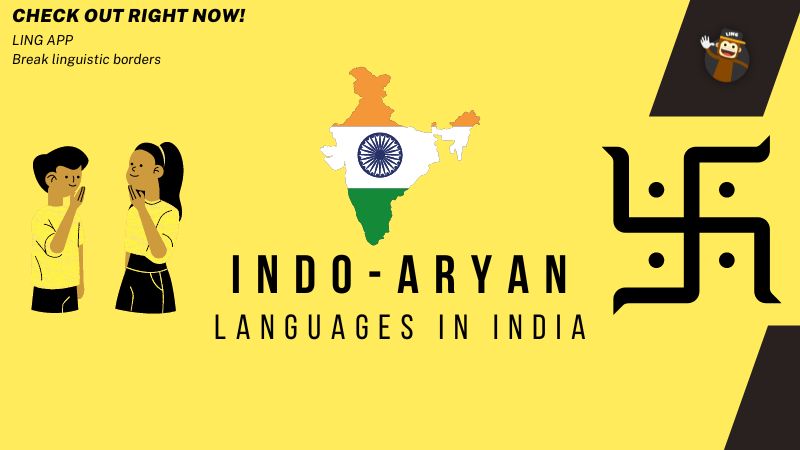Although America is always referred to as the melting pot, India holds that status in every way. Be it culturally, racially, or linguistically, the Indian subcontinent is home to everything. Linguistically speaking, India has the highest number of languages spoken worldwide, most of which are Indo-Aryan languages (including Punjabi). There are just so many Indo-Aryan languages in India, and we will be discuss those in this article. Let’s get started!
The Indo-Aryan languages are the ones that are locally spoken by the people mainly living in South Asia, Sri Lanka, Nepal, and the Maldives. However, it is also spoken in Northwest Europe, Southeast Africa, Australia, Western Asian regions, and many other places. Also known as Indic languages, this one is spoken by almost one billion people. Its language features are derived from the Indo-Iranian languages.
Who Were The Aryans?
Now that you know a little about the Indo-Aryan languages, let’s shed some light on who the Aryans were. In ancient times, the name Aryan was given to the people residing in Iran and the Indo-Pak subcontinent.
Aryan is a word derived from the Sanskrit word Arya which means distinguished. Aryan was just a synonym of Indo-European languages, explicitly referring to Indo-Iranian languages. There are a few hypotheses about this, and here are the two most common theories that have a general consensus.
Theory #1
They were a race that appeared in the mid-19th century. These people settled in the subcontinent and shaped the culture of united India. These people were then superseded by Hinduism.
Theory #2
Many scholars have neglected the existence of Aryans as a Race. Instead, they believe that the term Aryan has nothing to do with race, and the root of this word is social and not an ethnic one.
Geographical Distribution
The Indo-Aryan languages are spoken to date by almost a billion people. These descend from the old languages such as Sanskrit and, after that, through Middle Indo-Aryan languages, for example, Prakrits. The following data represents some of the Indo languages still spoken natively.
- Assamese (15 million)
- Awadhi (20.5 million)
- Bengali (245 million)
- Bhojpuri (53 million)
- Chhattisgarhi (19 million)
- Deccan (11 million)
- Dhundari (9 million)
- Gujarati (46 million)
- Haryanvi (13 million)
- Hindi (180 million)
- Kashmiri (4.6 million)
- Konkani (7.6 million)
- Magahi (13 million)
- Maithili (35 million)
- Marathi (68 million)
- Marwari (13 million)
- Mewati (5 million)
- Nepali (17.2 million)
- Odia (40 million)
- Oriya (32million)
- Punjabi (125 million)
- Rajasthani (60 million)
- Romani (4 million)
- Shekhawati (3 million)
- Sinhala (17 million)
- Urdu (60.5 million)
3 Major Divisions Of The Indo Aryan Language
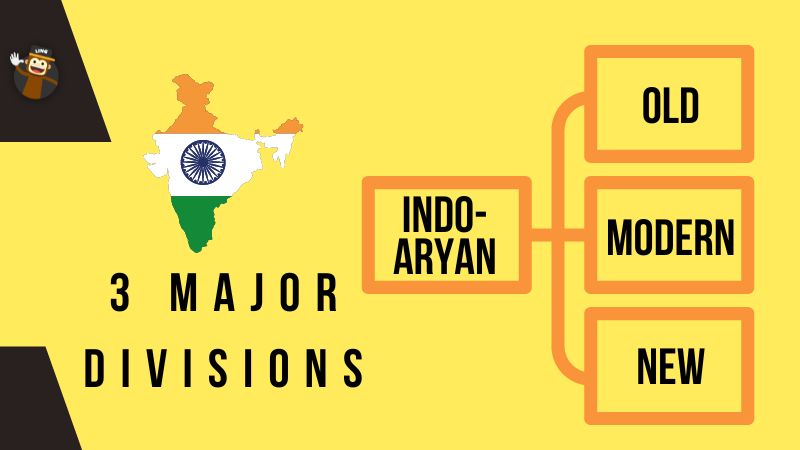
Old, Middle, and New (or Modern) Indo-Aryan are the three main divisions of Indo-Aryan languages that linguists usually agree upon. The names of these divisions are essentially linguistic in nature and are listed in the sequence in which they first emerged. These reflect the coexistence of previous and latter divisions instead of their total replacement.
Old Indo-Aryan languages
Regional languages and dialect forms collectively referred to as Sanskrit is included in Old Indo-Aryan. There is a definite distinction between post-Vedic Sanskrit and Vedic Sanskrit. The Post-Vedic Sanskrit has lost some essential elements from its older forms.
The grammarian Pini (5th–6th century BCE) correctly differentiates between the spoken language of his day and is used appropriately in the language of sacred writings, Vedic usage, etc. Scholars also distinguish between other dialects of the language, which is why they use terms like Epic Sanskrit and Classical Sanskrit.
Modern Indo-Aryan Languages
Manuscripts from the third century BCE to the fourth century C.E. were written in Middle Indo-Aryan, containing several literary languages. The dialects of Apabhra reflect the most recent phase of evolution in the Middle Indo-Aryan.
Although “Prkrit” refers to all Middle Indo-Aryan languages, Apabhraa is typically excluded when discussing the Prkrits.
Identifying the origin of Proto-Indo-Aryan is challenging. The only evidence found, probably the earliest is that the Upper Doab (Ganges-Yamuna Doab) of Uttar Pradesh and the majority of the present-day Punjab state in India, Punjab province in Pakistan, and Haryana were the earliest Indo-Aryan speaking regions in the Indian subcontinent.
New Indo-Aryan Languages
Finally, moving on to the contemporary form of Indo-Aryan languages, AKA new Indo-Aryan languages. There are now many new Indo-Aryan languages in use.
According to the 2001 census, more than 790,625,000 persons in India, or more than 75% of the population of that time, spoke at least one Indo-Aryan language. As of 2003, twenty-two languages were designated as scheduled or legally recognized languages under the Indian Constitution.
Hindi in the Devanagari script has been selected as the official language of the Union by Article 343 of the Indian Constitution. Additionally, states including Madhya Pradesh, Uttarakhand, Uttar Pradesh, Uttaranchal, Bihar, Chhattisgarh, Haryana, Rajasthan, and Himachal Pradesh have made the language their official tongue.
However, this statistic does not distinguish between the several speech groups that are legitimately classified as different languages.
Classification And Groups
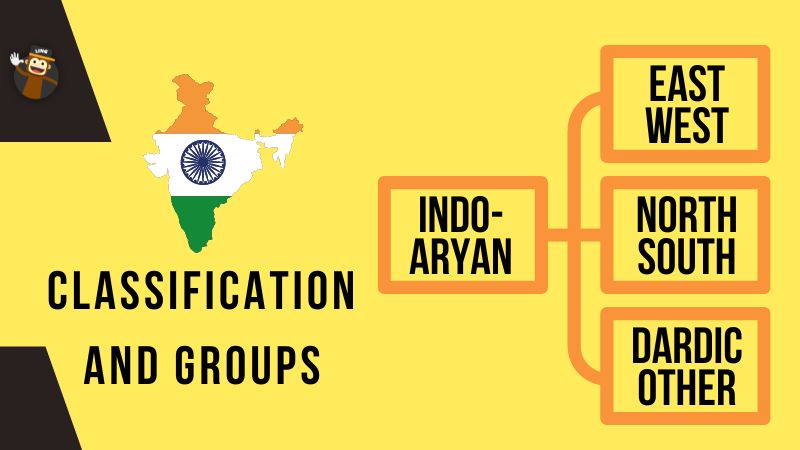
Northwestern Zone
The Indian subcontinent’s northwest is home to speakers of northwest Indo-Aryan languages. Shauraseni Prakrit is thought to be the origin of Northwestern languages. Punjabi is mainly spoken in Punjab, a northern Indian state that has also made it its official language.
Eastern Zone
The Eastern Indo-Aryan languages, sometimes known as Magadhan languages, are spoken by people in the eastern subcontinent, which encompasses the states of Odisha and Bihar and other areas near the northwest Himalayan corridor.
Central Zone (Madhya Or Hindi)
The majority language of India’s Hindi Belt and Gangetic Plains, apart from Delhi and the surrounding regions, is Hindi, and it regularly transitions with neighboring dialects in this context. Like Braj and Awadhi, several have illustrious literary and poetic histories.
Hindi, a Sanskritized standardization of the Khariboli language, is the formal language authorized by the Indian government. After Urdu, it is the second most widely used language worldwide.
Northern Indo-Aryan Languages
The northern Indo-Aryan languages are also known as the Pahari, spoken in Nepal and northwest India. It is classified into three areal dialects, Eastern Pahari, Central Pahari, and Western Pahari are divided into languages and dialects.
Western Zone
In central and western India, Madhya Pradesh and Rajasthan speak Western Indo-Aryan languages.
Gujarati, the official language of Gujarat, is spoken by more than 50 million people. Numerous Romani languages are spoken throughout Europe by the Romani people, a nomadic tribe who originally hails from India.
Other Groups
There are also other groups of the Indo-Aryan languages, including Northern Zone, Southern Zone, Insular Indic, Dardic languages, and Unclassified, which are also widely spoken in India.
Linguistic Complexities And Comparisons
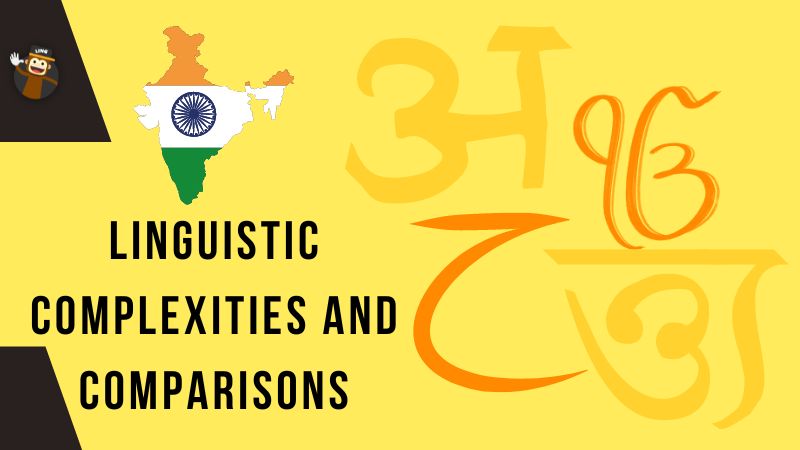
Finally, let’s look into some tidbits of the linguistic complexities of Indo-Aryan languages belonging to the Indo-Aryan speakers.
Hindustani
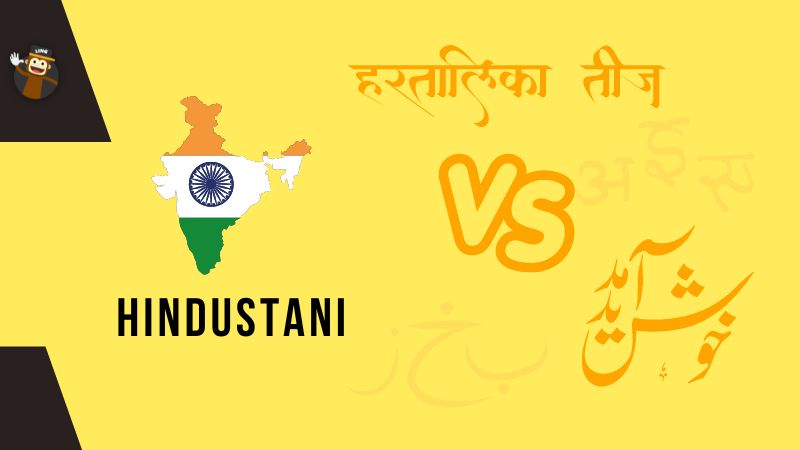
Hindustani is an epic mixture of Hindi and Urdu language. At a basic level, Hindi and Urdu have nearly identical grammar and an extensive vocabulary common in both languages.
At a higher level, however, the two languages vary because Urdu primarily draws from Persian and Arabic, whereas Hindi borrows extensively from Sanskrit. Therefore, Hindi is written using the Devnagari script, whereas Urdu uses a modified Arabic alphabet.
Hindi is widely studied, taught, spoken, and understood throughout the Indo-Pak subcontinent, whether as a first or second language, despite having its home area in the north of India. Urdu is primarily spoken in Pakistan but is also widely spoken in many Muslim-populated regions of India, like Gujrat and Lucknow.
The historian Alok Rai quotes the origin of Hindustani in India beautifully, “The Indian subcontinent’s cultural blending gave birth to this universal language, which over time has gone by the titles Hindavi, Hindustani, Hindi, Urdu, or Rekhta.“
Writing Scripts
The script Hindi follows is the Devnagari script.
The Devnagari consonant is always followed by an inherent “a” sound (pronounced like the “a” in “bark”), except when it comes at the end of the word ending in a consonant in some cases (pronounced like the “a” in “assign”). It is either not uttered or is muted, which is why each consonant in the transliteration ends in an “a.”
You should also know that each Devnagari letter stands for a syllable; therefore, the system is strictly a “syllabary” instead of an “alphabetic” one. Remember that Devnagari does not write in caps.
Bengali

Bengali is the official language of Tripura, West Bengal, and Assam, during the second official language of Jharkhand. The Bengali language in Bangladesh and India has different vocabulary and pronunciation.
There are two literary subgenres in Bengali: Shadhubhôsha (সাধুভাষা ), or “beautiful language,” and Chôlitôbhasha (চলিতভাষা), or “current language.”
The former is a traditional literary style based on Middle Bengali of the fifteenth century. In contrast, the latter is a twentieth-century innovation based on educated people’s speech in Calcutta.
The most significant distinctions between the two writing styles are in the pronoun forms and verb conjugations.
Writing Script
The Brahmi script brought forward the Bengali alphabet (Bangla lipi), also known as the Eastern Nagari script or Eastern Neo-Brahmic script. It began to deviate in the eleventh century from the Devanagari alphabet, from which it started to shift in the eleventh century. The two are closely related to each other.
When Charles Wilkins created Bengali printing in 1778, the modern printed version of the Bengali alphabet emerged. The 19th century saw the modernization of a few ancient letters.
Punjabi

Although Punjabi is an ancient language, its literary history began quite late and is spoken widely in Punjab. Punjab is a territory that is on both sides of the Pakistani-Indian border. The inhabitants of Punjab and the speakers of Punjabi are known as Punjabis. The script was written in Gurmukhi using Devanagri.
Writing Script
The official script for Punjabi is the Gurmukhi script in India, developed from the Nagari script. It is different from Pakistani Punjabi. While it was not in its simplest form, Guru Nanak, the founding member of the Sikh religion, brought Punjabi a fresh perspective.
The Adi Grantha, or Guru Granth Sahib, composed by the fifth Master, Arjun Dev, was not entirely written in Punjabi. In addition to Chandi di Var, written in Punjabi, all of the holy writings by the tenth and final Lord, Guru Govind Singh (1666–1708), were written in Old Hindi.
Grammar
The grammar of Punjabi is akin to other Indo-Aryan languages. Like all of these languages, Punjabi is composable, meaning it modifies roots by adding suffixes to form words to indicate grammatical relationships.
Marathi
Marathi, often referred to as Maharashtri, is an Indo-Aryan language that belongs to the Indo-European linguistic family. India’s fourth most widely spoken language is closely tied to Punjabi and Hindi.
In India, particularly in Maharashtra, Marathi is the mother tongue of 72 million people and is expressed as a second language by an additional 3 million people.
Its vast speakers are also spread in Isreal and Mauritius, and India.
Writing Script
Marathi was first written down around 700 AD. Marathi’s long literary tradition began with religious writings in the 12th and 13th centuries.
Marathi has been written using the 52-symbol Devanagari script since 1950. (16 vowels and 36 consonants).
Gujarati
Gujarati is an Indo-European language among India’s 22 officially recognized languages and 14 local dialects. Many Indian actors speak and promote Gujrati. Gujarati is relatively new compared to most other Indian languages because its roots date back to the 12th century A.D.
Writing Script And Grammar
Formal Gujarati grammar was developed by eminent scholar and Jain monk Hemchandracharya. However, this was seen as “Apabrahmsa” grammar—a debased variant of the formal languages of the time—and was therefore disapproved of.
Like other Nagari syntaxes, the Gujarati alphabet is in abugida, a variant of the Devanagari script.
Rajasthani
Rajasthani is a Western Indo-Aryan language with over 80 million native speakers. Most of its users reside in Punjab, Gujarat, other surrounding Indian states, and Rajasthan.
Rajasthani descended from Old Gujarati, also known as Maruwani, Maru-Gurjar, or Gujjar Bhakha, which existed in Rajasthan and Gujarat around 1100 and 1500 AD. Among the several dialects of Rajasthani are Shekhawati, Bagri, Dhundhari, Marwari, Mewari, Harauti, Mewati, and Ahirwati.
Some Rajasthani dialects are so diverse from one another that some people think they are whole different languages.
The Rajasthani government sees it as a distinct language and formally recognizes it as a state language. Did you know that Rajasthani was considered a Hindi dialect in the late 19th and early 20th centuries?
Wrapping Up

Congratulations on making it so far. Learning a language is an epic brain workout, and Ling App can be your personal trainer.
We provide top-notch, cutting-edge, and successful language learning lessons at Ling. Anyone who wants to learn Punjabi can profit immensely from the Ling App.
Ling App makes study resources for the language available to everyone, regardless of location or time of day. The Gurmukhi Alphabet, primarily used in India and one of the most commonly spoken languages in the world, is likely the focus of your study if you are learning Punjabi.
Why not join the majority of Punjabi students who have chosen Ling as their success partner? Prepare to become proficient in Punjabi quickly by downloading the Ling App from the Google Playstore or App Store right away.
